Leonard T. Gerow
| Leonard Townsend Gerow | |
|---|---|
 | |
| Nickname(s) | "Gee" |
| Born |
July 13, 1888 Petersburg, Virginia, United States |
| Died |
October 12, 1972 (aged 84) Petersburg, Virginia, United States |
| Allegiance |
|
| Service/branch |
|
| Years of service | 1911–1950 |
| Rank |
|
| Unit |
|
| Commands held |
29th Infantry Division V Corps Fifteenth Army Command and General Staff College Second Army |
| Battles/wars |
World War I World War II |
| Awards |
Distinguished Service Medal (3) Silver Star (3) Legion of Merit (2) Bronze Star Air Medal |
| Relations | Lee S. Gerow (brother) |
General Leonard Townsend Gerow (July 13, 1888 – October 12, 1972) was a highly decorated senior United States Army officer who served with distinction in both World War I and World War II.
Early life
Gerow was born in Petersburg, Virginia. The name Gerow is derived from the French name "Giraud". Gerow attended high school in Petersburg and then attended the Virginia Military Institute (VMI). He was three times elected class president.[1] He graduated as recipient of the "Honor Appointment" which, at the time, permitted one man in each VMI graduating class to become a Regular Army second lieutenant without further examination. He was commissioned as a second lieutenant into the Infantry Branch of the United States Army on 29 September 1911.
Early military career
Prior to World War I, Gerow served in a series of assignments as a company grade officer in the Infantry. In 1915 he won commendation for his work in the 1915 Galveston Hurricane that struck Galveston, Texas. He served in Vera Cruz in the Mexican Campaign. He was promoted to first lieutenant on 1 July 1916 and later to captain on 15 May 1917, shortly after the American entry into World War I on 6 April 1917.
From 16 January 1918 to 30 June 1920 he served on the Signal Corps staff on the Western Front. He was promoted to the rank of temporary colonel, in charge of purchasing all the radio equipment for the American Expeditionary Force (AEF) in Belgium and France. For his services during the war he earned the Army Distinguished Service Medal and the French Legion of Honour.
After returning to the United States, he was promoted to the permanent rank of major on 1 July 1920. He was ordered to attend the advanced course at the U.S. Army Infantry School at Fort Benning, Georgia, in the fall of 1924. He graduated first in the class in 1925 from the Advanced Course at the Infantry School. Omar Bradley graduated second. Gerow attended the U.S. Army Command and General Staff School, where Dwight D. Eisenhower was his study partner, and graduated in 1926, ranking 11th in the class of 245. In 1931 he completed the Field Officer's Course in Chemical Warfare and Tanks and took a course at U.S. Army War College.
Gerow served in China in 1932 in the Shanghai sector. On 1 August 1935 he was promoted to the permanent rank of lieutenant colonel. On 1 September 1940, prior to the American entry into World War II, he became a colonel in the permanent grade and a month later, on 1 October 1940 became a temporary brigadier general.
World War II
Gerow was promoted to major general on 14 February 1942, over two months after the United States entered World War II, and became Commanding General (CG) of the 29th Infantry Division, an Army National Guard formation, on 16 February 1942. He received the Legion of Merit on 27 September 1943 for his work as a division commander and as Assistant Chief of Staff of the War Plans Division. He continued as commander of the 29th Division until 17 July 1943.
He became commander of V Corps on 17 July 1943. This was the largest unit of troops in the European Theater of Operations (ETO). He played a major part in the planning of the invasion of continental Europe. He was the first corps commander ashore on D-Day, June 6, 1944 and continued in command through the Battle of Normandy, which saw his divisions sustain heavy casualties. V Corps was initially composed of two infantry divisions: the veteran 1st and the green 29th, his old division, now commanded by Major General Charles H. Gerhardt. He commanded V Corps was from 17 July 1943 to 17 September 1944 and again from 5 October 1944 to 14 January 1945. Gerow kept close to his advancing troops in V Corps. He was the first American officer of the rank of major general to enter Paris after its liberation by the French 2nd Armored Division and the U.S. 4th Infantry Division. For his part in this campaign he was awarded the Silver Star.
Both General Dwight D. "Ike" Eisenhower, the Supreme Allied Commander on the Western Front, and Lieutenant General Omar Bradley, the U.S. 12th Army Group commander, held Gerow in high regard and ranked him as one of the top American field commanders of World War II.[2] In a February 1945 memo General Eisenhower listed the principal American commanders in order of merit based on the value of their service during the war. Gerow was listed 8 of 32.[3] In a letter to General George Marshall, the Army Chief of Staff, on April 26, 1945, regarding commanders who might go on to serve in the Pacific, Eisenhower commended Bradley most highly and then said: "In Europe there are other men who have been thoroughly tested as high combat commanders, including Simpson, Patch, Patton, Gerow, Collins, Truscott and others. Any one of these can successfully lead an Army in combat in the toughest kind of conditions.".[4]
Gerow was given command of the newly formed Fifteenth Army on 15 January 1945. He was promoted to lieutenant general on 6 February 1945, with the promotion being effective 1 January 1945.
Post–World War II career

After the war Lieutenant General Gerow was appointed Commandant of the U.S. Army Command and General Staff School. He was placed in charge of a board which studied and proposed how army colleges ought to be organized, post war. In February 1946 the Gerow Board recommended five separate colleges. In January 1948, he was appointed Commanding General of the Second Army. This was his last post; he retired from the army, after almost 40 years service, in July 1950. Gerow was appointed a full general on July 19, 1954 by a special Act of Congress (Public Law 83-508).
Gerow's brother, Lee S. Gerow graduated from the VMI in 1913 and rose to the rank of brigadier general.
Awards and decorations
| Distinguished Service Medal with two oak leaf clusters | |
| Silver Star with two oak leaf clusters | |
| Legion of Merit with oak leaf cluster | |
| Bronze Star with oak leaf cluster | |
| Air Medal | |
| Mexican Border Service Medal | |
| World War I Victory Medal | |
| American Defense Service Medal | |
| American Campaign Medal | |
| European-African-Middle Eastern Campaign Medal | |
| World War II Victory Medal | |
| Army of Occupation Medal | |
| Order of the Bath, Companion (Great Britain) | |
| Order of Suvorov, Second Class (Russia) | |
| Legion of Honour, Commander (France) | |
| Croix de guerre with palm (France) | |
| Order of Leopold II, Grand Officer with Palm (Belgium) | |
| Croix de guerre with palm (Belgium) | |
| Order of the Oak Crown, Grand Officer (Luxembourg) | |
| Order of Military Merit (Chile), First Class | |
| Order of the Ayacucho, Grand Official (Peru) | |
| Order of Military Merit, Grand Officer (Brazil) | |
| Order of Aeronautical Merit, Grand Officer (Brazil) |
References
External links
- "Leonard T. Gerow". Find a Grave. Retrieved 2009-05-15.
| Military offices | ||
|---|---|---|
| Preceded by Milton Reckord |
Commanding General 29th Infantry Division 1942–1943 |
Succeeded by Charles H. Gerhardt |
| Preceded by Russell P. Hartle |
Commanding General V Corps 1943–1944 |
Succeeded by Edward H. Brooks |
| Preceded by Ray E. Porter |
Commanding General Fifteenth Army January 1945 – October 1945 |
Succeeded by George S. Patton |
| Preceded by Manton S. Eddy |
Commandant of the Command and General Staff College 1945–1948 |
Succeeded by Karl Truesdell |
| Preceded by John T. Lewis |
Commanding General Second Army 1948–1945 |
Succeeded by James Van Fleet |